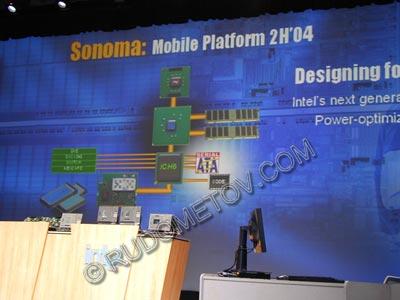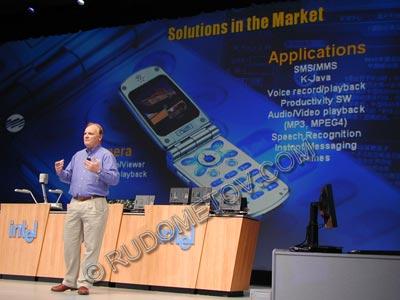It is published on site Fcenter
IDF Fall 2003, mobility
Victor Rudometov.
authors@rudometov.com
 On September, 17th, 2003 in San Jose (California, the USA) has continued operation of Intel Developer Forum (IDF) - the largest international developer forum hardware and the software. This day has been devoted transportable processing techniques.
On September, 17th, 2003 in San Jose (California, the USA) has continued operation of Intel Developer Forum (IDF) - the largest international developer forum hardware and the software. This day has been devoted transportable processing techniques.

Transportable processing techniques as usually, Anand Chandraseker (Anand Chandrasekher), holding represented a post of the vice-president of corporation Intel and controlling division on transportable platforms. This time together with it (Ronald Smith), holding a post of the vice-president of corporation Intel and responsible Ronald Smith appeared in wireless processing techniques.



 Fig. 1. Anand Chandraseker (at the left) and Ronald Smith (on the right)
Fig. 1. Anand Chandraseker (at the left) and Ronald Smith (on the right)

Some announcements of new processors and chip sets first minutes were the most considerable event, an event during the key report, at once.


First, a chip set i855GME which possesses new possibilities of saving of the electric power. Processing technique support
energosberezhenija for the display (Intel Display Power Saving - DPST) is carried out. Saving can reach 25 % at saving of excellence of the map.



 Fig. 2. The announcement of a new chip set i855GME
Fig. 2. The announcement of a new chip set i855GME

And the given function switches on depending on usage of the secondary generator of a notebook or a mains supply. On the key report the presentation has been led. In the beginning a notebook
zapitali from a network, thus consumption of power supply was up to standard 5 W. At disconnecting from a network, the system
energosberezhenija the screen has switched on. Consumption has decreased to 3.5 W. At videoclip playing at which brightness of the screen varied, consumption increased a little, but and did not reach 5 W.



 Fig. 3. Lowering energopotreblenija at transition to battery backup
Fig. 3. Lowering energopotreblenija at transition to battery backup


 Fig. 4. Change energopotreblenija at videoclip playing
Fig. 4. Change energopotreblenija at videoclip playing

The processor under code name Dоthan became the following loud announcement. It is the processor of Pentium-M of following generation, it is fulfilled on processing technique of 90 nanometers, from 140 million by transistors on a chip. The processor is equipped by cache memory L2 in the size of 2 Mb. The processor with kernel Dothan should go on sale in 4th quarter of this year.



 Fig. 5. The announcement of new processor Dothan
Fig. 5. The announcement of new processor Dothan

Testing of two systems, one on the basis of the old processor, and another with new processor Dothan has been made. Testing included arithmetic and multimedia tests. As a result the new processor has shown the big productivity and smaller
energopotreblenie.



 Fig. 6. At the left on Centrino still there is an operation, and on the right the new
Fig. 6. At the left on Centrino still there is an operation, and on the right the new
 Processor Dothan has already completed operation
Processor Dothan has already completed operation

Further the new system which in the near future will substitute flowing Centrino has been presented. Have named this system Sonoma. It is supposed, what exactly it will widely use in 2004.



 Fig. 7. The announcement, systems Sonoma
Fig. 7. The announcement, systems Sonoma

Structure Sonoma will include processor Dothan, the integrated solution for wireless access to standard networks 802.11a/b/g, and also a new chip set with code name Alviso. This chipset will differ the integrated graphics solution of following generation and support PCI Express, interface NEWCARD, dynamic storage DDR2, Serial ATA and the new audiointerface with code name Azalia.



 Fig. 8. System Sonoma includes the majority of the technological
Fig. 8. System Sonoma includes the majority of the technological
 Novelties of 2003
Novelties of 2003

Anand Chandraseker also has shown new maps for PCI Express and the new display with reduced
energopotrebleniem.



 Fig. 9. Matching PCMCIA and PCI Express maps
Fig. 9. Matching PCMCIA and PCI Express maps

Ronald Smith as the expert in transportable network wireless processing techniques, has presented at once some novelties. Among them new handheld computers, mobile phones, etc.



 Fig. 10. Ronald Smith represents advanced design
Fig. 10. Ronald Smith represents advanced design

Ronald Smith considers, that the market of transportable arrangements will shortly vary, arrangements become more difficult. Such functionality will be realised, about which else more recently even it was difficult to dream. Especially it concerns mobile phones. For an example can be: audio playing in format MP3, video in MPEG4, creation of videoconferences and many other things. Shortly, each phone and a handheld computer will be completed with cameras with a high-resolution.



 Fig. 11. Representation of phone of the future
Fig. 11. Representation of phone of the future

For such transportable arrangements with the new processor of Intel XScale (code name Bulverde) new processing techniques use some. Among them:

 Intel Wireless MMX - additional instructions for an expedition of multimedia, simplification of carrying over of software products with PC.
Intel Wireless MMX - additional instructions for an expedition of multimedia, simplification of carrying over of software products with PC.

 Intel Quick Capture - integration with a photo and videocameras, full-length video, photos with quality 4-x the megapixel camera.
Intel Quick Capture - integration with a photo and videocameras, full-length video, photos with quality 4-x the megapixel camera.

 Intel Wireless SpeedStep - processing technique energosberezhenija which will allow to increase an operating time of the transportable arrangement.
Intel Wireless SpeedStep - processing technique energosberezhenija which will allow to increase an operating time of the transportable arrangement.



 Fig. 12. New processing techniques
Fig. 12. New processing techniques

For demonstrating of possibilities of the new processor high-quality 3D-games have been shown some.


It is necessary to mark, that for multimedia of solutions, such as qualitative audio and video, the big capacity of a network is necessary. At present, the transportable network is yet ready to such loads. However step-by-step the industry will advance new processing techniques. For example WCDMA in 2005 it will be capable to give 2 Mbps for data transfer, that in 50 times more than GPRS allows now.



 Fig. 13. Evolution of standards of transportable networks
Fig. 13. Evolution of standards of transportable networks

Thus, development of a transportable platform will be prompt. In the modern transportable arrangements nearest year-another will receive practically all possibilities of usual computers and even more. The multimedia will develop, high-speed wireless access becomes an integral part of the modern arrangement, and computational capabilities will grow steadily according to Moore's law.

To pass to razrelu Processors



Intel Wireless MMX - additional instructions for an expedition of multimedia, simplification of carrying over of software products with PC.
Intel Quick Capture - integration with a photo and videocameras, full-length video, photos with quality 4-x the megapixel camera.
Intel Wireless SpeedStep - processing technique energosberezhenija which will allow to increase an operating time of the transportable arrangement.